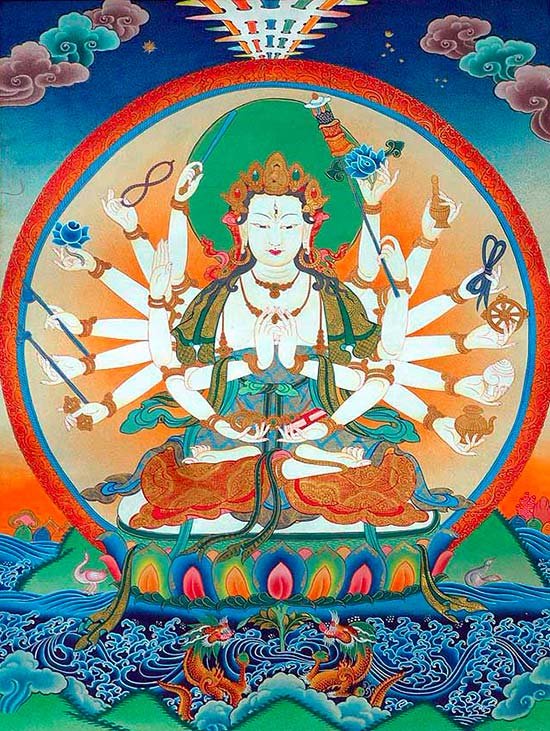Maha Prajnaparamita Sastra
by Gelongma Karma Migme Chödrön | 2001 | 941,039 words
This page describes “the vaisharadya-sutra” as written by Nagarjuna in his Maha-prajnaparamita-sastra (lit. “the treatise on the great virtue of wisdom”) in the 2nd century. This book, written in five volumes, represents an encyclopedia on Buddhism as well as a commentary on the Pancavimsatisahasrika Prajnaparamita.
Preliminary note (1): The Vaiśāradya-sūtra
The basic canonical text is the sūtra on the fearlessnesses vouched for by numerous sources:
1. Pāli wording in the Vesārajjasutta: Anguttara, II, p. 8–9; Majjhima, I, p. 71, l. 32–72, l. 14:
Cattār’ imāni Sāriputta tathāgatassa vesārajjāni yehi vesārajjehi samannāgato tathāgato āsabhan ṭhānaṃ … dukkhakkhayāyāti, tatra vata maṃ…na samanupassāmi… etaṃ p’ahaṃ… viharāmi.
2. Sanskrit wording in Kośavyākhyā, p. 645, l. 30– 646, l. 13; Pañcaviṃśati, p. 211, l. 1–15; Śatasāhasrikā, p.1448, l. 6–1449, l. 17; Arthaviniścaya, p. 578–579:
Catvārīmāni Śāriputra tathāgatasya vaiśāradyāni yair vaiśāradyaiḥ samanvāgatas tathāgato’rhan … na samanupaśyāmi, idam ātra nimittam… sahadharmeṇa.
3. Chinese translations: Tseng yi a han, T 125, k. 19, p. 645b17; k. 42,p. 776c21–777a2; Vibhāṣā, T 1545, k. 31, p. 158a17–b13; Pañcaviṃśati, T 223, k. 5, p. 155b23–c20; T 220, vol. VII, k. 415, p. 81a-b20.
Transl. of the Sanskrit. – Here, O Śāriputra, are the four fearlessnesses of the Tathāgata; endowed with these fearlessnesses, the Tathāgata, the holy One, fully and completely enlightened, who claims the noble place of the bull (var. of the Ṛṣi), rightly utters the lion’s roar in the assembly and turns the wheel of Brahmā. What are these four?
1. While I claim to be fully and completely enlightened, I see no reason to fear that a śramaṇa, a brahmaṇa, a god, Māra, Brahmā or anyone in the world can legitimately object that such and such dharmas are unknown to me. Seeing no reason to fear that, I have obtained security, absence of fear, certainty, and I abide there; I claim the noble place of the bull (var. Ṛṣi), I rightly utter the lion’s roar in the assembly and I turn the wheel of Brahmā never yet set in motion legitimately by a śramaṇa, a brāhmaṇa, a god, Māra, Brahmā or anyone in the world.
2. While I claim to have destroyed the impurities, I do not see any reason to fear that a śramaṇa… can legitimately object that such or such impurities have not been destroyed by me. Not seeing any reason to fear that…
3. I see no reason to fear that a śramaṇa… can legitimately claim that the dharmas presented by me as obstacles to the Path do not constitute obstacles in the person who brings them into play. Seeing no reason to fear that…
4. I see no reason to fear that a śramaṇa… can legitimately claim that the way shown by me as the noble path leading to release does not lead the person who follows it to the proper cessation of suffering, to the suppression of suffering. Seeing no reason to fear that, I have obtained security, absence of fear, certainty, and I remain there; I claim the noble place of the bull (var. of the Ṛṣi), I utter the lion’s roar rightly in the assembly and I turn the Wheel of the Dharma never yet legitimately set in motion by a śramaṇa, brāhamaṇa, god, Māra, Brāhma or anyone in the world.
